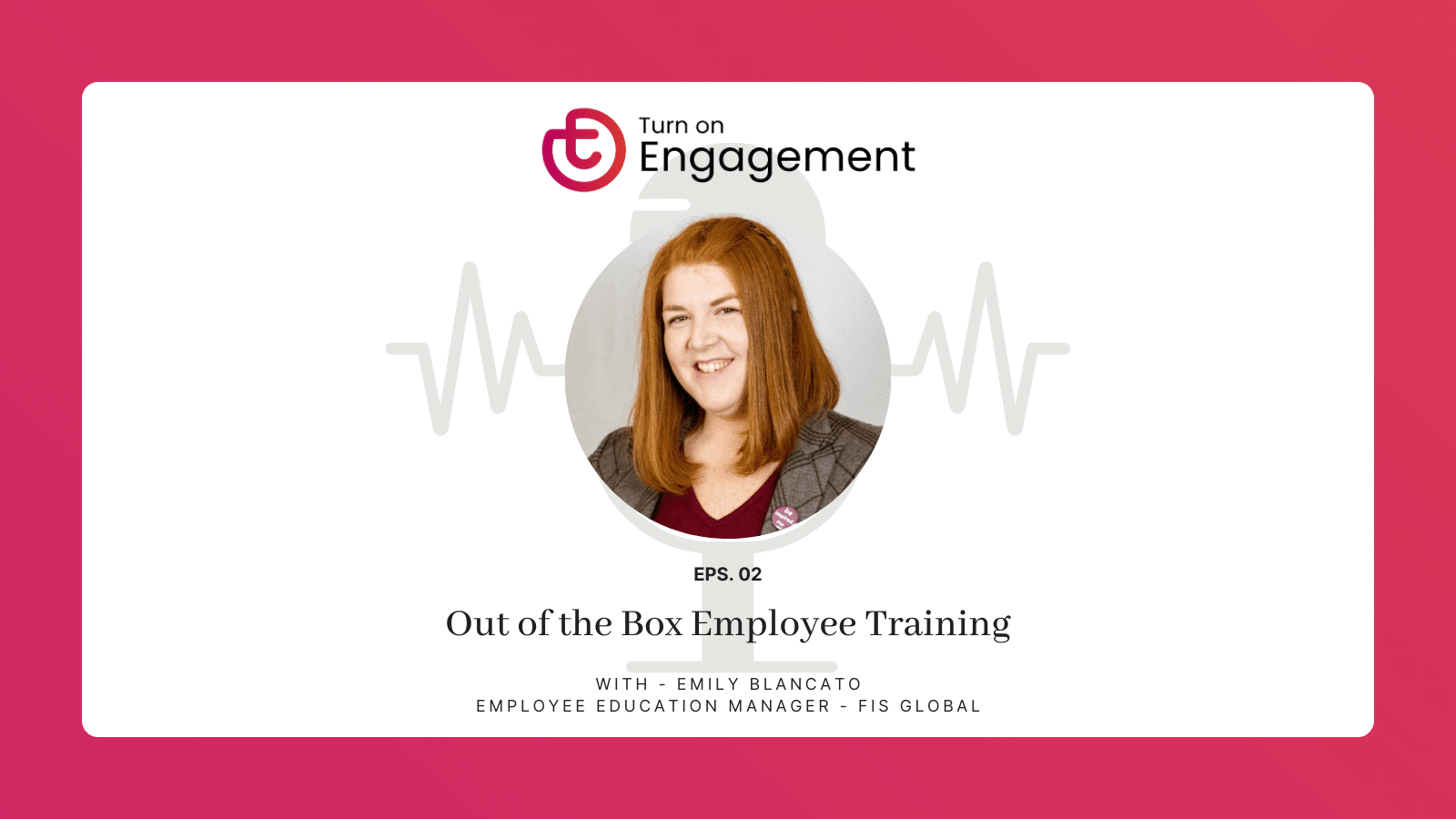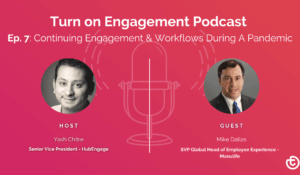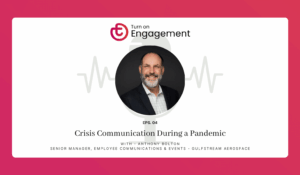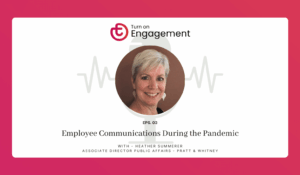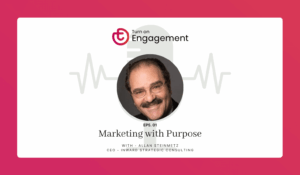Yash talks to Emily Blancato from FIS Global about how to take employee education and training out of the box so you can empower your employees to be brand ambassadors with some powerful onboarding programs that have proven to be so successful that they are rolling it out to a much larger network. Emily showcases the true strength of out-of-box techniques for employee training with a case study that you don’t want to miss.
Follow and listen to the Turn on Engagement Podcast on your favorite audio streaming platforms: Spotify, Google Podcasts, Apple Podcasts, Tune In, iHeartRadio, and RSS.
Podcast Transcript:
Yash Chitre: Hey there, it’s Yash Chitre from HubEngage, with the Turn on Engagement podcast, today we’ve got Emily Blancato from FIS global, a very large fintech services company with over 4000 employees. And she’s going to talk about how she’s been able to take employee education and training outside of the box empowering employees to become brand ambassadors for the company through some pretty cool onboarding programs that have been so successful they’ve got ambitious plans to roll it out even farther. Hear her full story and this 15-minute podcast and get inspired on how you can easily be creative with your employee learning and training programming. Stay tuned, it’s all coming up here on the Turn on Engagement podcast.
Yash Chitre: Hello everyone, and welcome to the Turn on Engagement podcast, I’m Yash Chitre, senior vice president of marketing and engagement here at HubEngage, and today I’ve got a very special guest with me, Emily Blancato, who is an employee education manager at FIS global, which is a very large financial services company based in New York I believe. Emily has done some really amazing stuff in the learning and training space, so I’m privileged and honored to have her on the podcast today, welcome Emily.
Emily Blancato: Thank you thank you happy to be here.
Yash Chitre: Thanks for being on. So, tell us a little bit about FIS global and some of the things that you’ve done there obviously I know training has been a challenge this year, and last year with COVID-19, you’ve had to change up the way you do things traditionally normally in terms of how you know traditional employee learning and training programs are done. Would really love to hear your story of how you’re doing it at FIS global.
Emily Blancato: Yeah great, let me give you a little history about FIS as a company maybe just a quick two-minute elevator pitch there, and then we’ll dive into the training side of it. So FIS is essentially a fintech company, we have clients that cross the gamut when it comes to wealth and retirement, our payment processing, core processing, so we interact with a lot of merchants who need the rails and networks that were connected to process payments for customers that come in and then for our banking side we’re helping them with the technology part of their business.
So if they need a system for core processing and if they need a credit card program and a system that does all the bells and whistles they want to tie to that they come to FIS and we help build something that is using our system but has parameter-driven pieces to it that they can kind of create their own experience so to speak with that, so overall we tend to work with a lot of businesses and our employees across the board typically interact with clients directly so it’s that business to business and we also offer business to the consumer if a client needs that type of service so very fast at the tech industry has certainly pushed us to the limit when it comes to change management and updating our technology to meet the business needs of our customers today.
Especially when it comes to the training world that can be a challenge for all of our staff because it can feel a little bit like whiplash where you’re going through multiple changes at once, not only technology changes but maybe organizational changes as we find better fits to align our talent across the business.
So when we first launch, my team specifically, which was focused on all of those employees that serve our business to business customers, so that might be someone who’s in client care that helps “with you have this problem you can’t get this thing done in the system” all the way through relationship and success management type roles or implementation rules where they’re actually implementing products for clients and we actually started the team up right before COVID actually hit the mainstream and everyone shut down March of last year and essentially we were a small team of about at the time five or six people, that had to figure out how to build training programs at scale for an audience over 4000 people.
And how we ended up figuring out how to do that was really leaning into the expertise that we had amongst our subject matter experts and what we noticed right away is with how fast the tech was moving and the products were getting developed, there is no way that we could have leaned into an old instructional design model where it takes six months to develop something and furthermore, we realize our audience didn’t want that because it tended to be almost overly polished where they lost the connection of where is where am I in this picture of this? And what we leaned into then is, well why don’t we just let the experts talk? And essentially what we ended up packaging was working with subject matter experts, getting them to record content either with us in an interview-style similar to this, or even using PowerPoint to do a quick demo of something that they are working through that they would then talk through.
The benefit that this offered us is one, we could have tense means recording simultaneously and then we would just be grabbing and polishing and editing their content essentially and then putting it in a container and curating that into a path based on what someone new might need to know in that role or if you transitioned from let’s say implementations into like a client care role, what are the things that you would need to shift about your responsibilities and understand to get there.
And with COVID, everyone was starved for connection. We immediately went remote, so you didn’t get that office interaction, a lot of people weren’t as comfortable with virtual using their cameras and collaborating in that manner. So the benefit on top of just being able to get the program done in a short amount of time so our audience could actually use it, was that it provided connection because now as a new hire I could join and I get to hear from all of the experts that are going to support me in my role and I know their name, I didn’t have to block them down to get their knowledge and sit next to them for an hour and ask questions, I wasn’t getting an experience that was maybe different than the person before me because every time this we did it maybe they changed how they delivered that content.
We’re able to give feedback and make it more repeatable so they have less stress when we’re already down a team member and they’re probably taking on more from a business perspective. And the new hire back to almost feel like the connection to the team where, “Oh well from this content this person created, they were really funny the way they put it together and they made some you know brought some key scenarios that were kind of humorous and that’s how they delivered so they could kind of understand a little bit more about the personality of the people that they were working with which made them more comfortable reaching out and connecting with those colleagues across the business and conversely on this me-side, they were actually able to have more valuable conversations with these new hires where it wasn’t just kind of a data dump where maybe the new hires feeling overwhelmed because someone who’s been a veteran of 10 years is basically telling them everything that they think is important in that moment. It allowed us to edit down with this news we’re providing and break it down into, how can someone actually digest this? what other content do we need to partner this from the industry to make sure that the new hire has what they need.
And this means having absolutely leaned in and loved the process so much so that we have now managers that encourage their team to record content, people are posting videos even if when it comes to time management and things about how to integrate you know Yammer into our team app and how to shut off Outlook notifications so you can really focus on what you need to get done and not get distracted but everything that pops up in our day. So overall, to sum that up I think the ultimate goal for us was a connection, making sure that people were aware of who they had with them and who they could lean on in this experience and that drove a greater sense of community across FIS and better partnership so I had an understanding of if I ask this person something I do understand what I’m asking them for and the time commitment it might require of them.
Yash Chitre: Wow this is great, so you know it sounds like almost like a repeatable trainable coachable process that you created and it sounds like you know you did it with the new hires and I’m wondering is this something that you could do for existing employees to or something that you’re planning to do maybe with your existing employees as they maybe are transitioning between roles or moving up in their career or something like that so that they could you know it’s almost like creating this library of experiences that other people can learn from.
Emily Blancato: That’s exactly what ended up happening and we are actually looking at doing that and on top of that an important piece of us, is we did have to I don’t want to say babysit because these are all you know great professionals but they were new to what we were asking them not everybody has like a YouTube channel outside of work or like a podcast that there is there fun thing to do on the side and so some of them were very nervous to get started
So we did have to do some hand-holding in the beginning to build the confidence of people who maybe didn’t like the sound of their voice and kind of tell them like well if someone was sitting next to you they hear your voice so you know just be comfortable with hearing it yourself and we’re actually working on trying to get a framework together so how do we build we’re using articulate rise for a lot of this stuff it’s easy to package what we get and we get a lot of varieties so it allows us to kind of put it in one container.
But now we’re creating a framework and creating courses specifically and how do you work with us to create great content for your teams? So we can get that in front of the leadership team so we don’t have to necessarily be around for someone to tackle this, they could tackle it, we could be working on another project they could be creating content, and then once they’re ready to package it and curate it and polish everything up, they then can call us in for that piece of it and this allows us to scale it across the organization because as I mentioned earlier we had a really small team and I mean every moment is precious so we are working on packaging that and we actually had when we piloted this, there were some veterans who had been with the company probably 20 years in their roles and they actually went through it and audited kind of what we put together to be, do we get the right notes in the right places based on what someone what’s important to someone?
And they came back and said “Oh my God” I learned things that I didn’t know because I never had a chance to meet Joe in that department and you know Rajneesh is a great resource for development, I wasn’t aware of what he did or that we even had a job like that. So most definitely it could be applied to people transitioning roles I think the challenge that we have ahead of us now or really, I’ll say opportunity because we’re really excited about it. But the opportunity is, how do we know that we have it connect these into role-specific jobs?
So, if I’m in a business analyst position today serving one specific product, how do we naturally package? So, you know like you could take these are ten roads that you could take that would develop your career and this is the outcome that you could reach. That’s the piece that is a little challenging now and there’s a lot of work we have to do around I think role definition across our teams, making sure that when someone says they are this title that there are similarities and what they’re actually doing in a day in the life of, but that’s what we’re focused on now is how do we scale it and then, more importantly, how do we create a pathway for career mobility using what we’re creating with our speeds.
Yash Chitre: That’s fantastic, and I would think that there is an opportunity I know this is mostly for internal consumption inside of FIS, but I’m wondering you know are there snippets or you know some Golden Nuggets that you can take out of this and create into your external brand awareness as well so that your customers also see this and learn a little bit about you know the employees and the culture and the things that you guys do at FIS. We often say you know sometimes the best way to sell out is to sell in, so selling inwards and so selling internally inside of your company and having your employees fee or sort of spokesman your employee brand ambassadors, I’m wondering if there’s a way that to you know to take it even a step further and show the rest of the world that.
Emily Blancato: Great comment and I would agree that there is, an element that gets a little bit more complicated externally as you do have to be mindful of like what brand image are we setting out there, making sure that we’re not you know mentioning you know client-specific names and you know calling any of that private information out but we have looked at that even from the perspective of how could we lead our clients to do this in their own shops because what we’ve noticed is if we have we’re working with a client who has a certain culture and they have not embraced this kind of active learning culture that I think most businesses are looking at and realizing they have to invest in because things are changing so fast.
We’re figuring out how do we encourage our clients to build programs like this because at the end of the day if our clients don’t have that learning culture and are not supporting their employees’ development, that does end up bleeding into our bottom line because that means that client might be having to call support more often than not because maybe they’re wearing multiple hats and they never have had a chance to really excel at this skill it’s just one of those things that when I have to do it I call.
So what we’re hoping to do eventually is if we can package the concept out to our clients and help better inform them of ways that they can get creative, that it’ll help not only with their learning culture and develop an ability for their employees, but it also helps us on the back end because we’re challenging our staff to educate our clients and how can you make this the last time they have to call in for this because nobody likes as I know personally for me if I’ve got a call somewhere cause I’m stuck I’m never happy about it.
Yash Chitre: Right.
Emily Blancato: My day was interrupted, so we are most definitely looking into that and I think it’s just the nuance of making sure we hit the right tone with that launch outward and especially with this many interviews I think it does show, that when the big company sometimes people can think like “oh it’s a big corporate company and you can lose touch of the amazing amount of talent” that are tied to that company that actually make it relevant. I think any organization that doesn’t recognize that their people are the best asset is maybe just a little out of touch, and that’s something we want to encourage with our clients that you know we want to help you in any way we can provide a better product because that’s our product at the end of it too. Even though it’s maybe not branded that way that is something that we’re putting out there as an experience to people across the world.
Yash Chitre: That’s exactly, I think you hit the nail on the head right there and that’s exactly I think how you have to think you know when you’re working and employee communications, employee training. All the things that you talked about there, it’s really all these subtle nuances that you have to think about when you’re putting out a program like this and how far just how far it can you take it and what can you get out of it you obviously don’t want things to backfire or there so, fascinating perspective, loved every minute of your story there.
I think we’re just out of time for today but I wanted to thank you very much for coming on the podcast here, you know we certainly hope to have you on again and I love to see what happens well where do you take this thing? Because it’s pretty exciting and it’s just a fascinating case study that I think will help not only your internal employee brand and your employer brand but again if you can take that and connect the dots to the external and your customers get to get a taste of that and see that, that’s going to help with selling the products and services that up by us offers and also you know it’s just your recruiting and your training and your retention programs and all that kind of stuff so I think it’s all threads in the same fabric so to speak so thank you, Emily, thank you for sharing the story with us today really appreciate it.
Emily Blancato: Oh, it was a pleasure, we love talking about learning and development here at FIS so I would be happy to come back, and if you’re interested in any of those links about our conferences that were demoing this stuff out, happy to send those your way as well.
Yash Chitre: That would be great, yeah and we will put those links directly into the description here, so if you’re listening to this podcast on YouTube or on our website you will be able to find the links there and you can certainly connect with Emily as well. Hopefully on LinkedIn or any other means. Thanks, Emily,
Emily Blancato: Thank you, have a great day.
Yash Chitre: Alright, take care.
Yash Chitre: Hey there employee communications and HR folks, we’ve got some big news to share over here at HubEngage. We’ve officially been made a Society of Human Resource Management Re-Certification Provider, so if your SHRM member and you’re in need of getting your mandatory re-certification credits, you can tune into our new webinar series where we educate and train you on a variety of HR-related topics and trends so you’re up to date on your continuing education requirement. SHRM is a great place for all things HR and with this exciting new partnership HubEngage has created, we can now recertify you while you turn on engagement at the same time inside of your company. For more details and to sign up for a re-certification course with one of our Hubengage SHRM certified experts, visit hubengage.com and click on the SHRM tab under resources to get started today.

